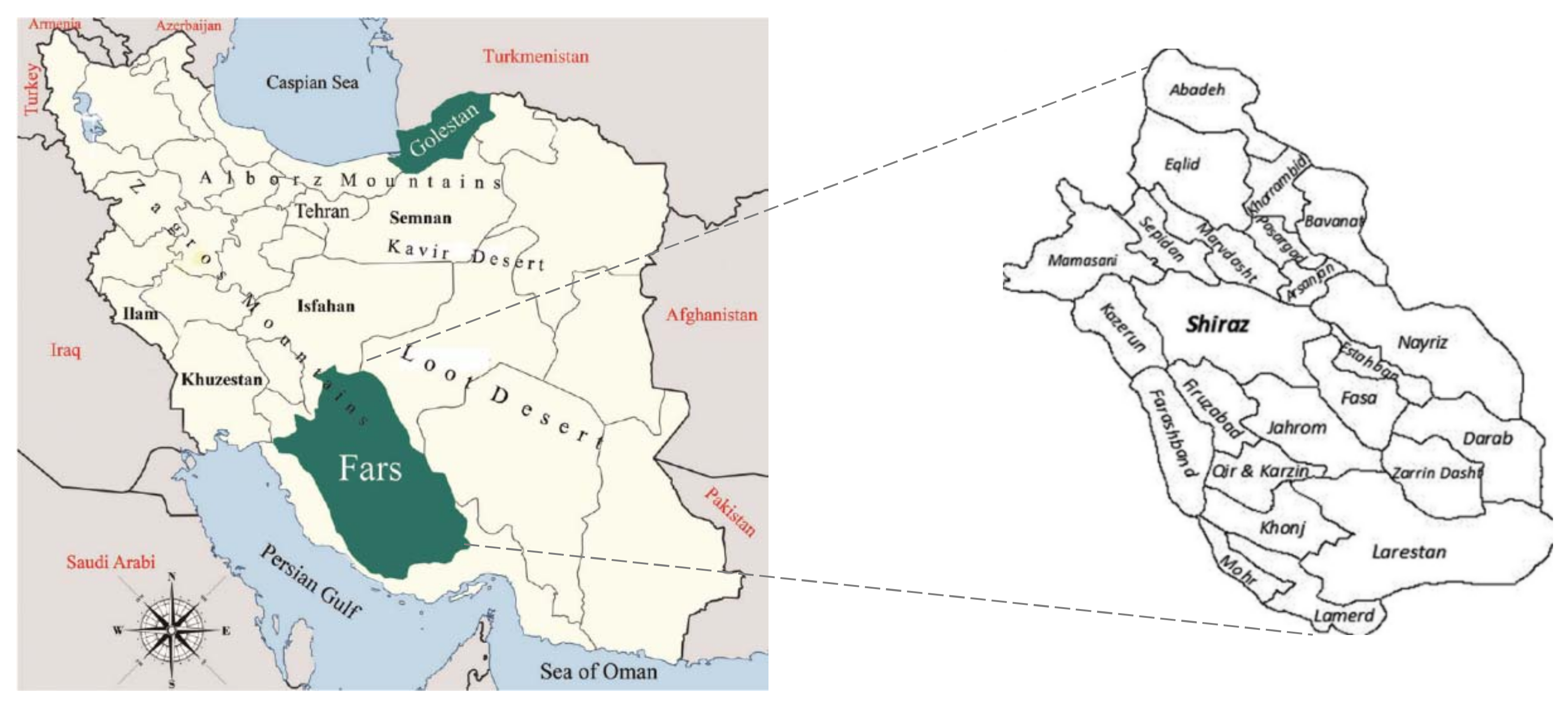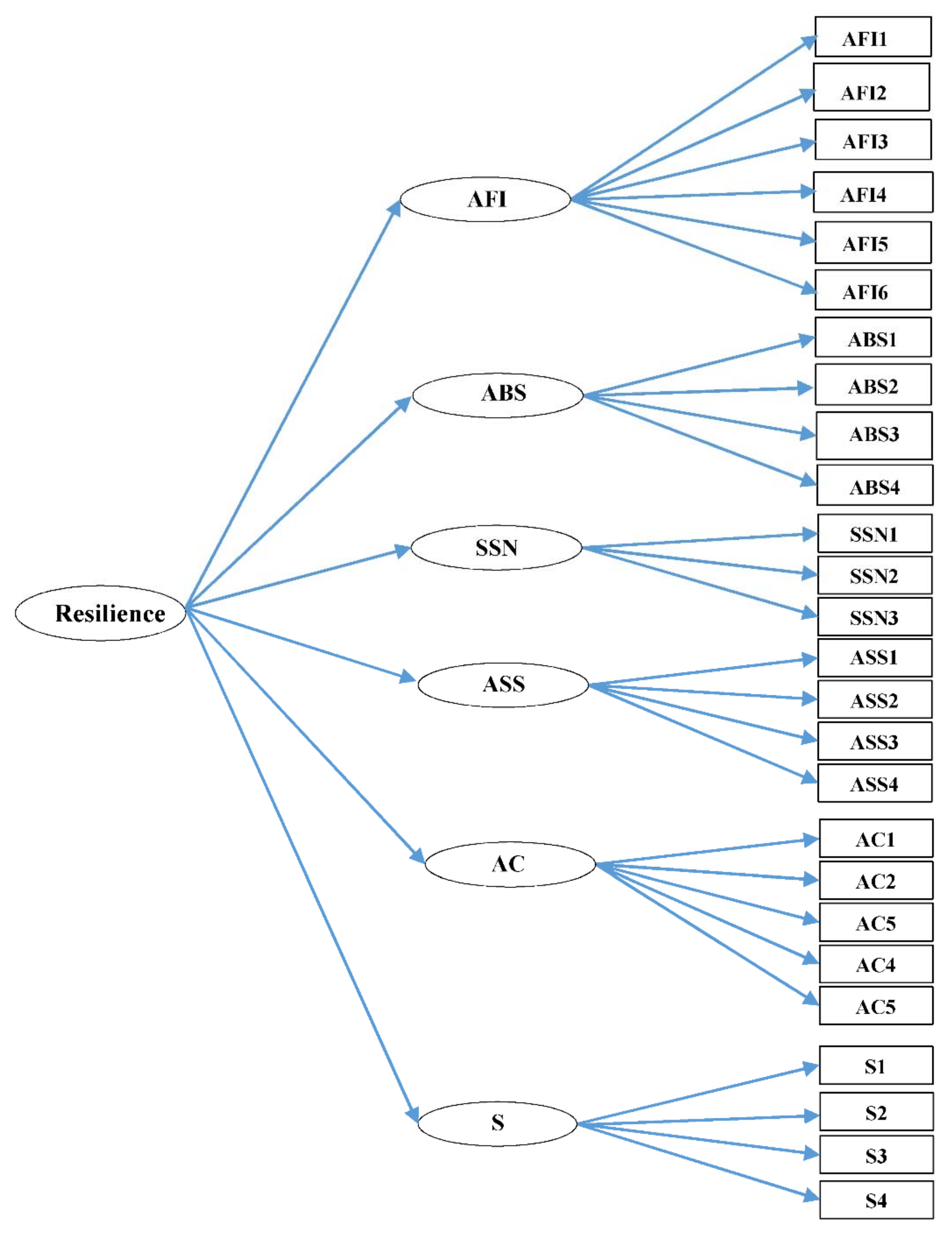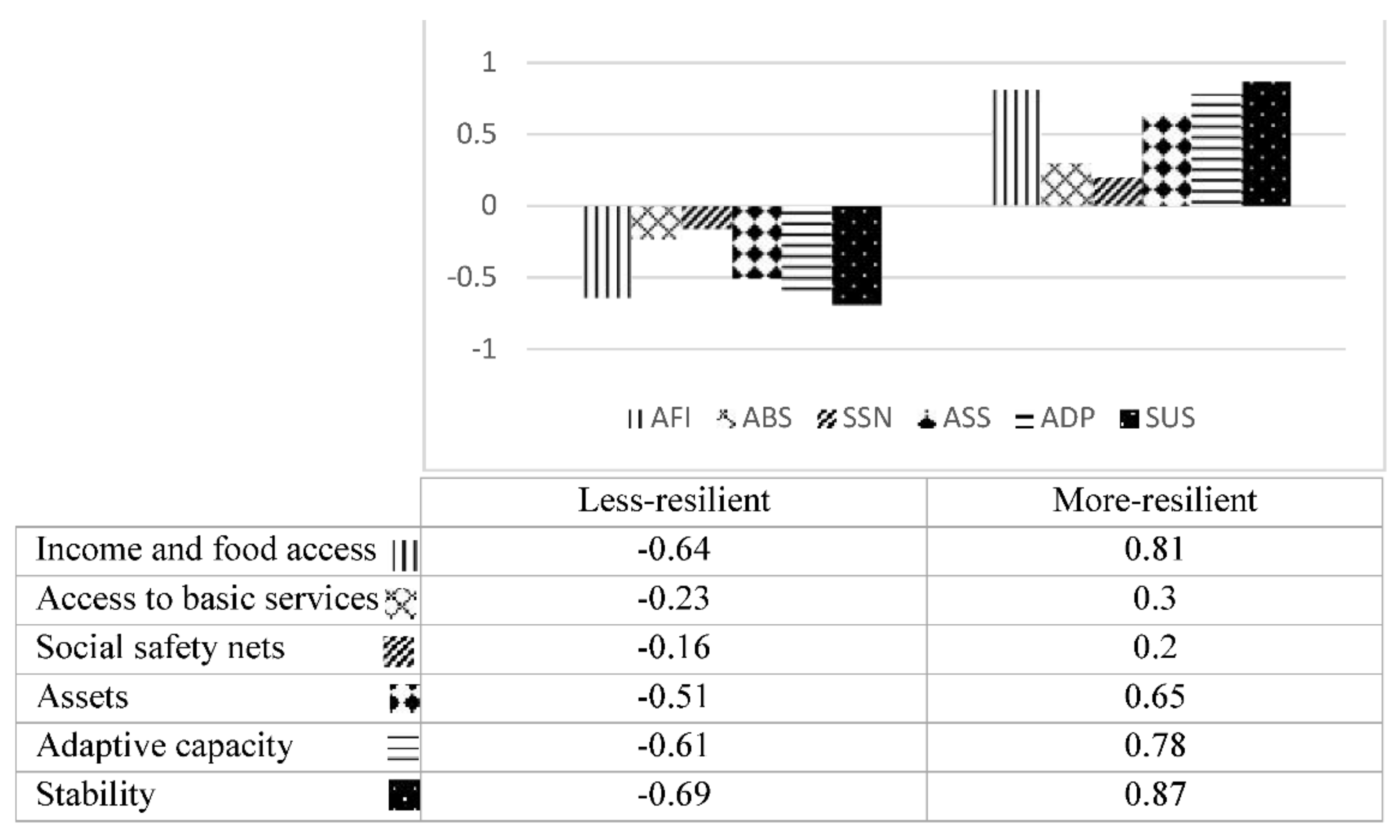Determining the Resilience of Rural Households to Food Insecurity during Drought Conditions in Fars Province, Iran
Abstract
:1. Introduction
2. Materials and Methods
Resiliency Measurement
3. Results and Discussion
3.1. Descriptive Statistics
3.2. Verifying the Resiliency Measuring Model
3.3. Resiliency Status of Rural Households
3.4. Characteristics Comparison between Resilience Groups
4. Conclusions
Author Contributions
Funding
Institutional Review Board Statement
Informed Consent Statement
Data Availability Statement
Conflicts of Interest
Abbreviations
References
- Bazza, M.; Kay, M.; Knutson, C. Drought Characteristics and Management in North Africa and the Near East; Working Paper; FAO: Rome, Italy, 2018; Available online: www.fao.org/3/CA0034EN/ca0034en.pdf (accessed on 1 July 2018).
- Liu, X.; Zhu, X.; Pan, Y.; Li, S.; Liu, Y.; Ma, Y. Agricultural drought monitoring: Progress, challenges, and prospects. J. Geogr. Sci. 2016, 26, 750–767. [Google Scholar] [CrossRef] [Green Version]
- Prokurat, E. Drought and water shortages in Asia as a threat and economic problem. J. Mod. Sci. 2016, 3, 235–250. [Google Scholar]
- Steffen, W.; Hughes, L.; Dean, A.; Rice, M. Climate Change and Drought; Climate Council of Australia Limited: Surry Hills, Australia, 2018; Available online: https://www.climatecouncil.org.au/wp-content/uploads/2018/06/CC_MVSA0146-Fact-Sheet-Drought_V2-FA_High-Res_Single-Pages.pdf (accessed on 7 June 2018).
- Food and Agriculture Organization of United Nations. Drought and Agriculture; FAO: Rome, Italy, 2019; Available online: http://www.fao.org/land-water/water/drought/droughtandag/en/ (accessed on 1 May 2020).
- Godfray, H.C.J.; Beddington, J.R.; Crute, I.R.; Haddad, L.; Lawrence, D.; Muir, J.F.; Pretty, J.; Robinson, S.; Thomas, S.M.; Toulmin, C. Food security: The challenge of feeding 9 billion people. Science 2010, 327, 812–818. [Google Scholar] [CrossRef] [PubMed] [Green Version]
- Pretty, J.; Sutherland, W.J.; Ashby, J.; Auburn, J.; Baulcombe, D.; Bell, M.; Bentley, J.; Bickersteth, S.; Brown, K.; Burke, J.; et al. The top 100 questions of importance to the future of global agriculture. Int. J. Agric. Sustain. 2010, 8, 219–236. [Google Scholar] [CrossRef]
- Rockström, J.; Steffen, W.; Noone, K.; Persson, Å.; Chapin, F.S.; Lambin, E.F.; Lenton, T.M.; Scheffer, M.; Folke, C.; Schellnhuber, H.J.; et al. A safe operating space for humanity. Nature 2009, 461, 472–475. [Google Scholar] [CrossRef] [PubMed]
- Food and Agriculture Organization of United Nations. Nigeria General Information; FAO: Rome, Italy, 2011. [Google Scholar]
- Food and Agriculture Organization of United Nations. Building Climate Resilience for Food Security and Nutrition; FAO: Rome, Italy, 2018; Available online: www.fao.org/state-of-food-security-nutrition/en/ (accessed on 11 September 2018).
- Food and Agriculture Organization of United Nations. Climate Change, Agriculture and Food Security; FAO: Rome, Italy, 2016; Available online: www.fao.org/3/a-i6030e.pdf (accessed on 1 July 2016).
- Alinovi, L.; Mane, E.; Romano, D. Towards the Measurement of Household Resilience to Food Insecurity: Applying a Model to Palestinian Household Data. 2008, pp. 52–137. Available online: ftp://ftp.fao.org/docrep/fao/011/i0430e/i0430e.pdf (accessed on 1 January 2008).
- Alinovi, L.; D’Errico, M.; Mane, E.; Romano, D. Livelihoods strategies and household resilience to food insecurity: An empirical analysis to Kenya. In Proceedings of the Conference on Promoting Resilience through Social Protection in Sub-Saharan Africa, Dakar, Senegal, 27–30 June 2010; Organized by the European Report of Development. FAO: Rome, Italy, 2010; pp. 28–30. [Google Scholar]
- Pasteur, K. From Vulnerability to Resilience: A Framework for Analysis and Action to Build Community Resilience; Practical Action Publishing: Rugby, UK, 2011. [Google Scholar]
- FAO; IFAD; WFP. Strengthening Resilience for Food Security and Nutrition: A Conceptual Framework for Collaboration and Partnership among the Rome-Based Agencies; Food and Agriculture Organization of the United Nations (FAO); The International Fund for Agricultural Development (IFAD); The World Food Program (WFP): Rome, Italy, 2015. [Google Scholar]
- Maleksaeedi, H.; Karami, E. Social-ecological resilience and sustainable agriculture under water scarcity. Agroecol. Sustain. Food Syst. 2013, 37, 1–29. [Google Scholar] [CrossRef]
- Maxwell, D.G. Measuring food insecurity: The frequency and severity of “coping strategies”. Food Policy 1996, 21, 291–303. [Google Scholar] [CrossRef] [Green Version]
- Adger, W.N. Institutional adaption to environmental risk under the transition in Vietnam. Ann. Assoc. Am. Geogr. 2000, 90, 738–758. [Google Scholar] [CrossRef]
- ADRC. In Particular Asian Disaster Reduction and Response Network. 2007. Available online: https://www.unisdr.org/files/10572_adrrndirectory.pdf (accessed on 24 September 2007).
- Bruneau, M.; Chang, S.; Eguchi, R.; Lee, G.; O’Rourke, T.; Reinhorn, A.; Shinozuka, M.; Tierney, K.; Wallace, W.; Winterfelt, D. A framework to quantitatively assess and enhance the seismic resilience of communities. Earthq. Spectra 2003, 19, 733–752. [Google Scholar] [CrossRef] [Green Version]
- Cutter, S.L.; Barnes, L.; Berry, M.; Burton, C.H.; Evans, E.; Tate, E.; Webb, J. A place-based model for understanding community resilience to natural disasters. Glob. Environ. Chang. 2008, 18, 598–606. [Google Scholar] [CrossRef]
- Folke, C. Resilience: The emergence of a perspective for social-ecological systems analyses. Glob. Environ. Chang. 2006, 16, 253–267. [Google Scholar] [CrossRef]
- Mayanga, J.S. Understanding and Applying the Concept of Community Disaster Resilience: A Capital-Based Approach. Ph.D. Thesis, Department of Landscape Architecture and Urban Planning, Hazard Reduction and Recovery Center, A&M University, College Station, TX, USA, 2006. [Google Scholar]
- Norris, F.H.; Stevens, S.P.; Pfefferbaum, B.; Wyche, K.F.; Pfefferbaum, R.L. Community Resilience as a Metaphor, Theory, Set of Capacities, and Strategy for Disaster Readiness. Am. J. Community Psychol. 2008, 41, 127–150. [Google Scholar] [CrossRef] [PubMed]
- Pfefferbaum, B.J.; Reissman, D.B.; Pfefferbaum, R.L.; Klopm, R.W.; Gurwitch, R.H. Handbook of Injury and Violence Prevention (Chapter 19). Building Resilience to Mass Trauma Events; Springer: New York, NY, USA, 2007; pp. 347–358. [Google Scholar]
- Rose, A. Defining and measuring economic resilience to disasters. Disaster Prev. Manag. Int. J. 2004, 13, 307–314. [Google Scholar] [CrossRef]
- Ciani, F. A Resilience-Based Approach to Food Insecurity: The Impact of Mitch Hurricane on Rural Households in Nicaragua. Ph.D. Thesis, University of Florence, Gainesville, FL, USA, 2012. [Google Scholar]
- Boukary, A.G.; Diaw, A.; Wünscher, T. Factors Affecting rural households’ resilience to food insecurity in Niger. Sustainability 2016, 8, 181. [Google Scholar]
- Kebede, T.; Haji, J.; Legesse, B.; Mammo, G. Econometric Analysis of Rural Households’ Resilience to Food Insecurity in West Shoa. Ethiopia. Food Secur. 2016, 4, 58–67. [Google Scholar]
- Statistical Center of Iran. The Yearly Book of Iran’s Statistics; Markaze Amare Iran: Persian, Iran, 2020; Available online: http://Salnameh.sci.org.ir/AllUser/DirectoryTreeComplete.aspx (accessed on 1 June 2020).
- National Monitoring and Drought. Report of Provinces and Counties Drought; Meteorological Organization: Tehran, Iran, 2018.
- Smit, B.; Skinner, M.W. Adaptation options in agriculture to climate change: A typology. Mitig. Adapt. Strateg. Glob. Chang. 2002, 7, 85–114. [Google Scholar] [CrossRef]
- Keshavarz, M.; Karami, E.; Vanclay, F. The social experience of drought in rural Iran. Land Use Policy 2013, 30, 120–129. [Google Scholar] [CrossRef]
- Portal of Agricultural Organization of Fars Province. Status Report of Agricultural Sector. Iran. 2018. Available online: http://www.fars.agri-jahad.ir/portal/home/ (accessed on 20 October 2018).
- Kolahdooz, F.; Najafi, F. Report of a National Survey: Food Security Information and Mapping System in Iran; Ministry of Health, Treatment and Medical Education: Tehran, Iran, 2015. [Google Scholar]
- Schaeffer, R.L.; Mendenhall, W.; Ott, L. Elementary Survey Sampling; PWS-Kent Publishing Company: Boston, MA, USA, 1990. [Google Scholar]
- Food and Agriculture Organization of United Nations. Globalization of Food Systems in Developing Countries: Impact on Food Security and Nutrition; FAO: Rome, Italy, 2013; pp. 45–50. [Google Scholar]
- Unay-Gailhard, I.; Balmann, A.; Appel, F. Dimensions of SURE-Farm Farm Typology for Farm Resilience Assessments; Working Paper [727520]; Leibniz Institute of Agricultural Development in Transition Economies (IAMO): Madrid, Spain, 2018. [Google Scholar]
- Tesso, G.; Emana, B.; Ketema, M. Analysis of vulnerability and resilience to climate change induced shocks in North Shewa, Ethiopia. Agric. Sci. 2012, 3, 871–888. [Google Scholar] [CrossRef] [Green Version]
- Frankenberg, E.; Sikoki, B.; Sumantri, C.; Suriastini, W.; Thomas, D. Education, vulnerability, and resilience after a natural disaster. Ecol. Soc. 2013, 18, 16. [Google Scholar] [CrossRef] [PubMed] [Green Version]
- Schirmer, J.; Hanigan, I. Understanding the Resilience of NSW Farmers: Findings from the 2015 Regional Wellbeing Survey; Health Research Institute and Institute for Applied Ecology, University of Canberra: Bruce, Australia, 2015; Available online: http://www.canberra.edu.au/research/institutes/health-research-institute/regional-wellbeing-survey/survey-results/reports/2015-reports/Resilience-of-NSW-farmers_2015RWS.pdf (accessed on 1 July 2016).
- Maleksaeidi, H.; Karami, E.; Zamani, G.H. Farm households’ resilience scale under water scarcity. Mitig. Adapt. Strat. Glob. Chang. 2015, 20, 1305–1318. [Google Scholar] [CrossRef]
- Boudreau, T. Livelihoods at the Limit: Reducing the Risk of Disasters and Adapting to Climate Change. In Evidence from the Consolidated Household Economy Analysis Database; Working Paper; The Food Economy Group; Save the Children: London, UK, 2013; Available online: http://www.savethechildren.org.uk/sites/default/files/docs/Reducing_the_Risk_of_Disasters.pdf (accessed on 22 July 2013).
- Folke, C.; Colding, J.; Berkes, F. Synthesis: Building resilience and adaptive capacity in social–ecological systems. In Building Resilience for Complexity and Change; Berkes, F., Colding, J., Folke, C., Eds.; Cambridge University: New York, NY, USA, 2003; pp. 352–365. [Google Scholar]
- Chambers, R. Climate Vulnerability and Capacity Analysis; Institute of Development Studies University of Sussex: Brighton, UK, 2009. [Google Scholar]



| Variables | Indicators |
|---|---|
| Income and Food access (IFA) | Amount of household income, limiting the amount of each meal, limiting the quality of each meal, reducing the number of meals per day, being without food in a whole day, and reduction in the amount of adult food in order to better children and employed members’ nutrition. |
| Access to basic services (ABS) | Access to a well-equipped health center, access to school in all levels, easy access to mobility and transport constraints. |
| Social safety nets (SSN) | Cash transfers from the Relief Committee, help and assistance of friends and relatives, participation and assistance from social groups. |
| Assets (ASS) | Land ownership (hectares), permanent assets (car, house, warehouse, garden, tractor, and shop/workshop, garden), livestock ownership (numbers) and income. |
| Adaptive Capacity (ac) | Diversified income, educational level of head of household, hope and effort to mitigate the consequences of crisis, belief in algebra and the availability of crises, self-confidence in abilities and compatibilities compared to others. |
| Stability (S) | The number of unemployed household members, the health status of household members (in last year), the level of trust among household members, and willingness to continue agricultural activities in future. |
| Variables | Minimum | Maximum | Mean | SD |
|---|---|---|---|---|
| Age (year) | 25 | 88 | 53 | 12.3 |
| Education level (years of schooling) | 0 | 18 | 6.8 | 4.6 |
| The present of households with diversified job and income (in addition of farming) (%) | 0 | 100 | 55.2 | 49.8 |
| Land ownership (ha) | 0 | 50 | 7.3 | 8.2 |
| Agricultural water access (scale) | 1 | 5 | 2.6 | 1.2 |
| Use of agricultural extension services(scale) | 7 | 25 | 12.6 | 4 |
| Use of crop insurance (scale) | 1 | 5 | 1.9 | 0.96 |
| Access to governmental credits and loans (scale) | 1 | 5 | 2 | 0.86 |
| Chi-Square Value/Degree of Freedom (x2/Df) | Significant Level (p) | Goodness of Fit Index (GFI) | Comparative Fit Index (CFI) | IFI | Root-Mean Square Error of Approximation (RMSEA) |
|---|---|---|---|---|---|
| 1.66 | 0.001 | 0.91 | 0.94 | 0.94 | 0.05 |
| Factor | Indicator | Mean | SD | Bar | ES | p-Value | α Cronbach (>0.6) | Pc > 0.6 | AVE > 0.5 |
|---|---|---|---|---|---|---|---|---|---|
| INF | INF1 | 3.1 | 0.87 | 0.8 | 0.89 | 0.97 | 0.9 | ||
| INF2 | 3.5 | 1.3 | 0.89 | 0.096 | 0.001 | ||||
| INF3 | 3.2 | 1.2 | 0.87 | 0.09 | 0.001 | ||||
| INF4 | 4.2 | 1.1 | 0.74 | 0.089 | 0.001 | ||||
| INF5 | 4.5 | 0.5 | 0.39 | 0.043 | 0.001 | ||||
| INF8 | 3.7 | 1.2 | 0.79 | 0.095 | 0.001 | ||||
| MS | MS1 | 3.04 | 0.86 | 0.73 | 0.62 | 0.90 | 0.78 | ||
| MS2 | 3.3 | 0.91 | 0.64 | 0.14 | 0.001 | ||||
| MS5 | 3 | 0.91 | 0.49 | 0.12 | 0.001 | ||||
| MS9 | 4.8 | 0.53 | 0.24 | 0.06 | 0.001 | ||||
| SSN | SSN1 | 1.15 | 0.54 | 0.43 | 0.56 | 0.78 | 0.54 | ||
| SSN7 | 1.24 | 0.53 | 0.53 | 0.23 | 0.001 | ||||
| SSN9 | 2.9 | 0.93 | −0.65 | 0.44 | 0.001 | ||||
| ASS | ASS1 | 2.53 | 0.7 | 0.56 | 0.06 | 0.001 | 0.6 | 0.94 | 0.81 |
| ASS5 | 1.7 | 0.79 | 0.6 | 0.067 | 0.001 | ||||
| ASS6 | 1.6 | 1.13 | 0.27 | 0.098 | 0.001 | ||||
| ASS7 | 2.4 | 0.9 | 0.47 | ||||||
| ADP | ADP1 | 2.5 | 1.1 | 0.49 | 0.18 | 0.001 | 0.73 | 0.92 | 0.68 |
| ADP2 | 2.8 | 0.81 | 0.52 | 0.14 | 0.001 | ||||
| ADP5 | 2.85 | 1.03 | 0.49 | ||||||
| ADP6 | 3.31 | 1.3 | 0.54 | 0.23 | 0.001 | ||||
| ADP8 | 3.1 | 0.89 | 0.82 | 0.19 | 0.001 | ||||
| ADP9 | 2.2 | 0.89 | 0.24 | 0.15 | 0.001 | ||||
| SUS | SUS1 | 2.9 | 1.1 | 0.66 | 0.72 | 0.96 | 0.85 | ||
| SUS3 | 3.9 | 1.1 | 0.75 | 0.1 | 0.001 | ||||
| SUS4 | 3.6 | 1.2 | 0.63 | 0.1 | 0.001 | ||||
| SUS8 | 3.5 | 0.77 | 0.48 | 0.07 | 0.001 |
| Ranking | Resilience Factors | Standardized Estimates (γ Coefficient) | p-Value |
|---|---|---|---|
| 6 | Basic services | 0.35 | 0.001 ** |
| 5 | Social safety nets | −0.90 | 0.001 ** |
| 4 | Assets | 0.895 | 0.001 ** |
| 3 | Access to income and food | 0.899 | 0.001 ** |
| 2 | Adaptive capacity | 0.91 | 0.001 ** |
| 1 | stability | 0.97 | 0.001 ** |
| Characteristics | Clusters of Resilience to Food Insecurity | T | p | |||
|---|---|---|---|---|---|---|
| Less-Resilience | More-Resilience | |||||
| Mean | SD | Mean | SD | |||
| Resilience | 87.3 | 6.3 | 66.2 | 7.9 | 23.6 | 0.000 |
| Age (years) | 50.39 | 12.6 | 55.67 | 11.5 | −3.6 | 0.000 |
| Education level | 8.6 | 4.67 | 5.3 | 3.8 | 6.2 | 0.000 |
| Number of household members | 3.9 | 1.1 | 3.7 | 1.2 | 0.8 | 0.3 |
| Income diversity | 3 | 1.1 | 2 | 0.9 | 7.1 | 0.003 |
| Employed rate | 0.2 | 2.4 | 0.1 | 0.16 | 2.9 | 0.000 |
| Land ownership | 9.59 | 11.8 | 6 | 7.6 | 3 | 0.01 |
| Crop variety | 2.75 | 1.2 | 1.95 | 0.9 | 6 | 0.000 |
| Water access | 3.2 | 0.87 | 1.9 | 2.1 | 7 | 0.03 |
| Livestock | 22.2 | 72 | 7.4 | 18 | 2.4 | 0.02 |
| Assets ownership | 4.2 | 1.3 | 3 | 1.2 | 7.5 | 0.000 |
| Access to extension | 14 | 4.4 | 11 | 3.2 | 5.9 | 0.000 |
| Access to loan and credits | 2.1 | 0.8 | 1.8 | 0.9 | 3 | 0.3 |
| Use of adaptation strategies | 84.1 | 9.8 | 76.7 | 8.7 | 6.6 | 0.000 |
Publisher’s Note: MDPI stays neutral with regard to jurisdictional claims in published maps and institutional affiliations. |
© 2021 by the authors. Licensee MDPI, Basel, Switzerland. This article is an open access article distributed under the terms and conditions of the Creative Commons Attribution (CC BY) license (https://creativecommons.org/licenses/by/4.0/).
Share and Cite
Nahid, N.; Lashgarara, F.; Farajolah Hosseini, S.J.; Mirdamadi, S.M.; Rezaei-Moghaddam, K. Determining the Resilience of Rural Households to Food Insecurity during Drought Conditions in Fars Province, Iran. Sustainability 2021, 13, 8384. https://doi.org/10.3390/su13158384
Nahid N, Lashgarara F, Farajolah Hosseini SJ, Mirdamadi SM, Rezaei-Moghaddam K. Determining the Resilience of Rural Households to Food Insecurity during Drought Conditions in Fars Province, Iran. Sustainability. 2021; 13(15):8384. https://doi.org/10.3390/su13158384
Chicago/Turabian StyleNahid, Nosha, Farhad Lashgarara, Seyed Jamal Farajolah Hosseini, Seyed Mehdi Mirdamadi, and Kurosh Rezaei-Moghaddam. 2021. "Determining the Resilience of Rural Households to Food Insecurity during Drought Conditions in Fars Province, Iran" Sustainability 13, no. 15: 8384. https://doi.org/10.3390/su13158384
APA StyleNahid, N., Lashgarara, F., Farajolah Hosseini, S. J., Mirdamadi, S. M., & Rezaei-Moghaddam, K. (2021). Determining the Resilience of Rural Households to Food Insecurity during Drought Conditions in Fars Province, Iran. Sustainability, 13(15), 8384. https://doi.org/10.3390/su13158384






